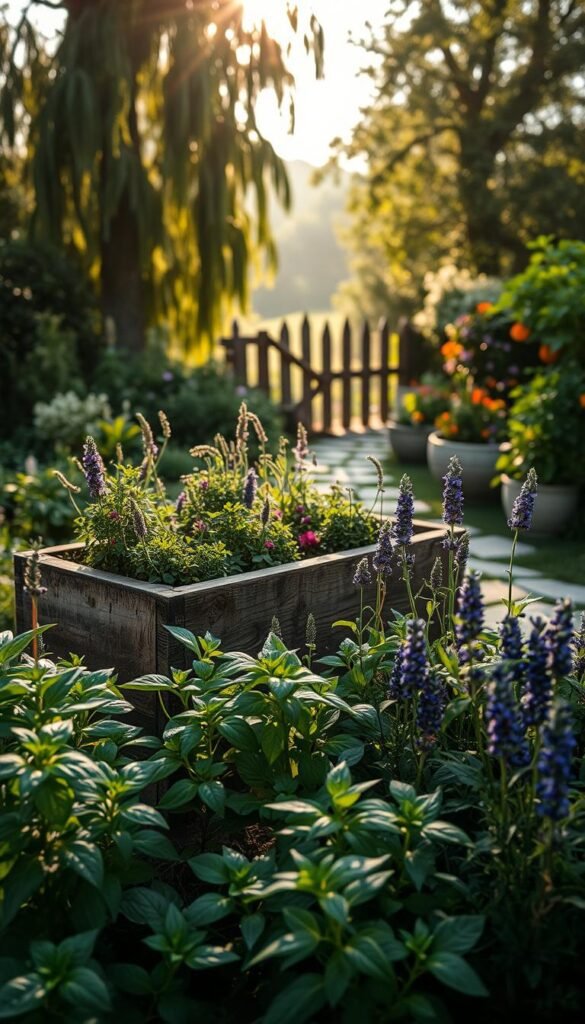Imagine stepping outside to a vibrant mix of textures, colors, and fragrances that serve your kitchen and wellness needs. Blending edible and ornamental varieties creates living art you can taste, smell, and admire daily. These versatile plants thrive in small spaces too – even urban balconies can host aromatic displays using clever container gardening hacks.
Recent studies reveal homegrown varieties retain 30% more antioxidants than store-bought dried versions. Beyond health benefits, they offer beginner-friendly gardening with lower maintenance than vegetable plots. Their leaves and blooms pair beautifully with flowers, creating layered visual interest from spring through fall.
You’ll learn how to design arrangements where mint’s ruffled edges complement lavender’s purple spikes, and thyme’s delicate flowers frame rosemary’s woody stems. We’ll explore placement strategies for maximum growth and beauty, whether you’re working with raised beds or windowsill planters.
This guide helps you cultivate a space that nourishes both body and soul. Discover plants doubling as natural remedies, gourmet ingredients, and stunning backyard focal points – all while deepening your connection to nature’s rhythms.
Why Consider a Herb Garden Aesthetic?
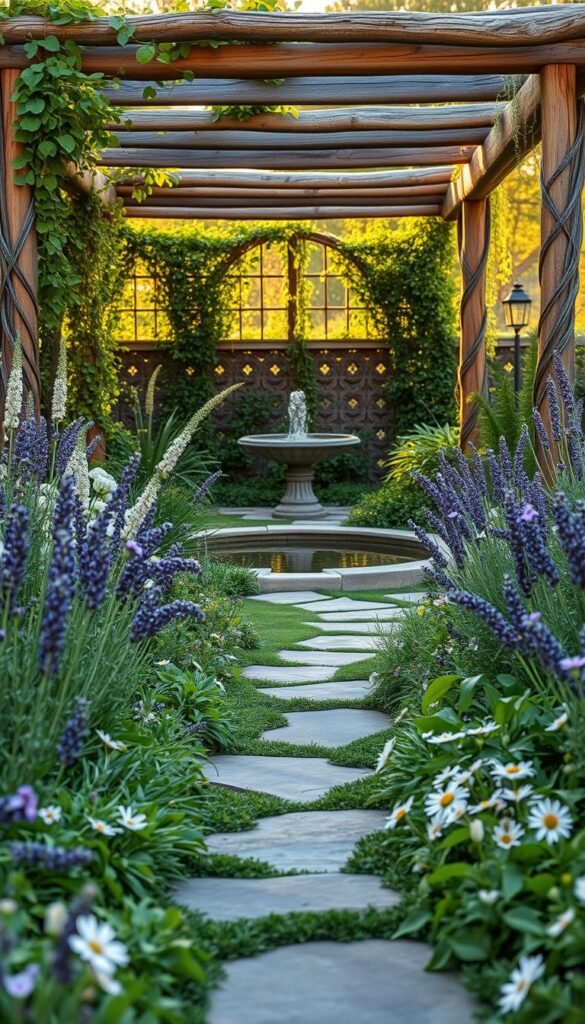
Transforming your outdoor area into a living tapestry offers more than fresh ingredients. It’s a gateway to mindfulness and creative expression, blending practicality with natural charm. Studies show tending green spaces lowers cortisol levels by up to 17%, making these plantings a wellness tool you can touch and taste daily.
Connecting with Nature and Wellness
Growing fragrant varieties invites calm into your routine. The act of nurturing sprouts strengthens your bond with seasonal cycles. Many leafy staples like lemon balm and chamomile soothe stress naturally, offering remedies you can brew or infuse.
Regular care becomes meditation. Snip mint for tea while listening to bees buzz among blossoms. This ritual creates pockets of peace in busy days, grounding you through scent and texture.
Enhancing the Beauty of Your Outdoor Space
Silver-green sage contrasts with purple basil’s deep hues, crafting painterly arrangements. Trailing oregano softens stone edges, while upright rosemary adds structure. These edible displays rival floral beds in visual impact.
Smart design choices maximize appeal. Try spiral layouts or color-themed clusters for elevating your space with a gardening. Containers let you rearrange textures as seasons change.
| Benefit | Visual Impact | Savings Potential |
|---|---|---|
| Fresh flavors on demand | Colorful foliage patterns | $3-$5 per store-bought bunch |
| Natural stress relief | Textural contrasts | 60% less waste vs. supermarket herbs |
| Seasonal interest | Blooms attract pollinators | Continuous regrowth cycles |
Planning Your Culinary and Medicinal Herb Garden
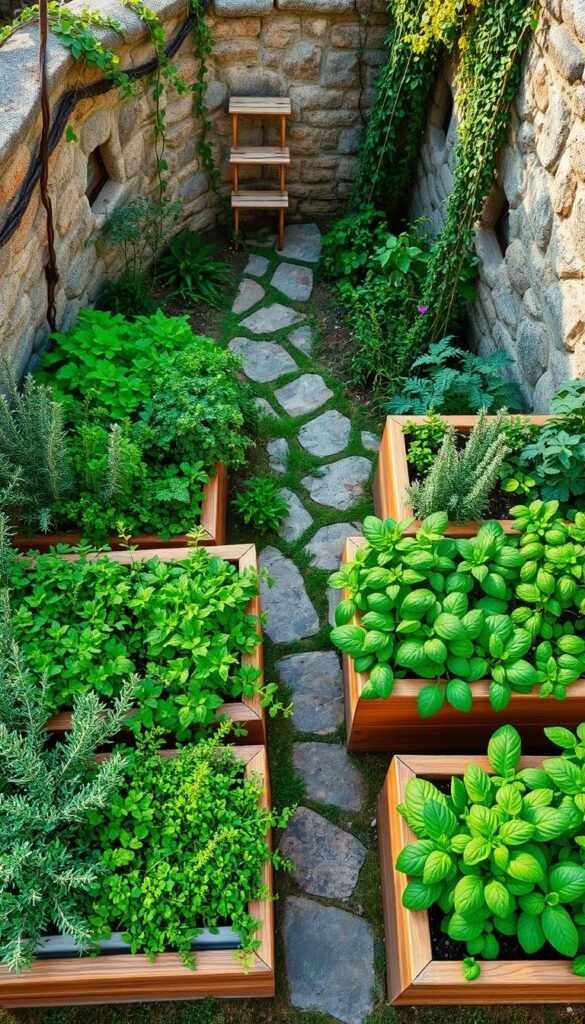
Creating a thriving green space starts with smart design choices. Whether you’re working with sprawling yards or compact patios, strategic placement ensures your plantings flourish while staying practical for daily use.
Selecting the Ideal Location
Most leafy varieties demand six to eight hours of direct sunlight daily. Scout areas near your kitchen for quick access while cooking. Well-drained soil prevents waterlogged roots – test drainage by digging a 12-inch hole and timing how fast it empties after filling with water.
Deciding on Container Versus In-Ground Planting
Containers offer unmatched flexibility, especially for renters or those with limited space. You can:
- Move pots to chase sunlight patterns
- Mix rosemary and thyme in vintage baskets
- Control soil pH for fussy varieties
Group species with similar water needs together. Basil and parsley thrive side-by-side, while lavender prefers drier conditions. Companion planting boosts growth – try pairing chives with roses to deter pests naturally.
Understanding Full Sun & Optimal Growing Conditions
Sunlight acts as nature’s power button for thriving plants. Many popular varieties evolved under intense Mediterranean rays, developing a need for generous light exposure. Meeting these requirements ensures vigorous growth and maximizes flavor compounds in leaves.
Importance of Well-Drained Soil
Six to eight hours of direct sun daily forms the baseline for success. Some varieties like rosemary thrive with even more exposure. Pair this with fast-draining earth to prevent soggy roots – a common killer of Mediterranean species.
Ideal earth mixes contain sand or grit for quick water movement. If your ground holds puddles after rain, amend it with:
- Coarse sand (30% of total volume)
- Perlite for aeration
- Compost to boost nutrients
Light-colored gravel mulch reflects heat upward, mimicking native habitats. This trick works wonders for potted plants too. Remember: healthy roots start with oxygen-rich soil that never stays waterlogged.
For families exploring indoor gardening with children, these principles still apply. Use south-facing windows and add grow lights during darker months. Proper drainage remains crucial – always choose containers with holes.
Top Culinary Herbs to Enhance Your Garden Aesthetic
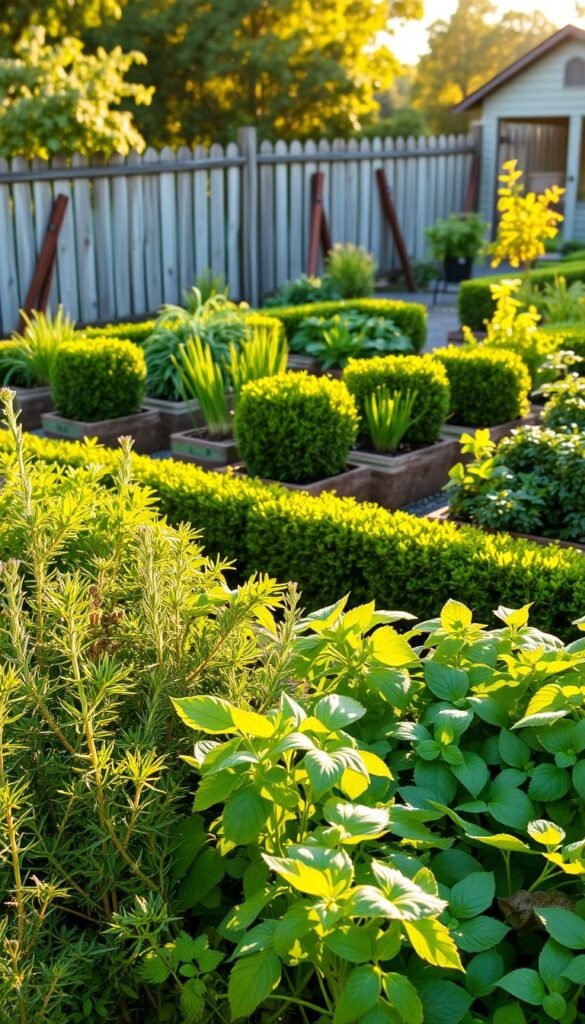
Elevate your outdoor space with three flavorful stars that double as living decor. Thyme, sage, and rosemary deliver bold tastes for your kitchen while creating striking visual textures. Their varied heights and foliage forms let you craft layered designs that captivate the senses.
Spotlight on Thyme, Sage, and Rosemary
Silver thyme transforms forgotten corners with silvery foliage and summer lavender blooms. This low-growing variety spills gracefully over stone walls or nestles between pavers, releasing minty aromas when touched. Its trailing habit makes it ideal for softening walkway edges.
‘Berggarten’ sage commands attention with broad, velvety leaves in muted gray-green tones. Unlike common sage, this cultivar forms tidy mounds perfect for framing garden entries. Watch for violet flower spikes in late spring that attract hummingbirds to your yard.
For vertical drama, ‘Salem’ rosemary offers upright growth with aromatic needle-like leaves. Its blue spring blossoms peek through evergreen branches, providing year-round structure. Use these woody stems as natural dividers between garden zones or as fragrant backyard hedges.
Pair these varieties to create dynamic contrasts. Silver thyme’s delicate sprawl complements sage’s bold foliage, while rosemary’s vertical lines anchor the composition. Together, they form a living tapestry that’s as practical as it is picturesque.
Medicinal Herbs with Powerful Benefits for Your Health
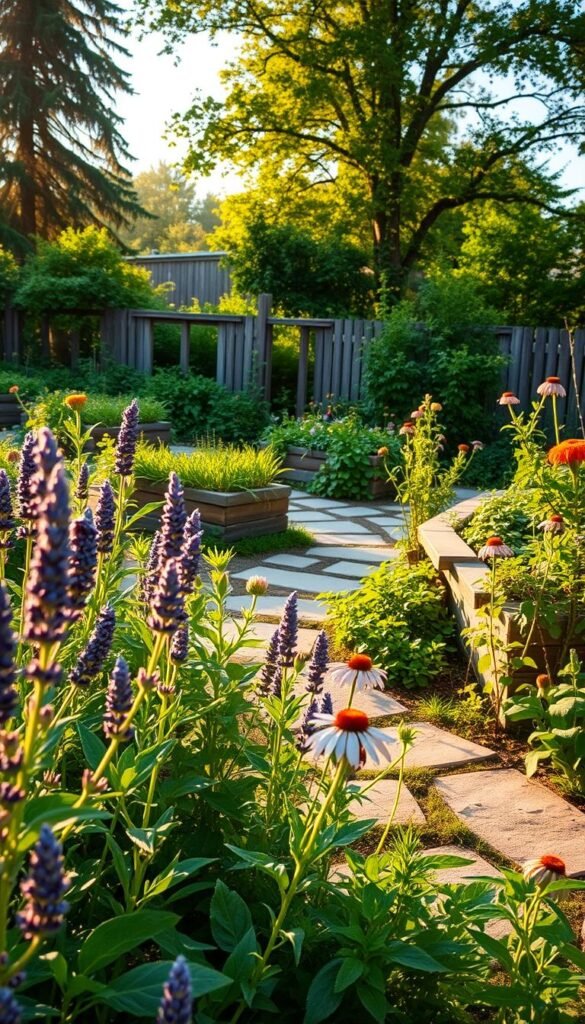
Your backyard holds untapped potential as a natural pharmacy. Growing healing plants lets you craft remedies while supporting biodiversity. Four standout varieties offer distinct wellness advantages through easy home preparations.
Nature’s Stress Relievers & Immune Boosters
Calendula’s sunny blooms work wonders on irritated skin. Infuse its petals in oil for salves that soothe cuts or rashes. This hardy perennial reseeds freely, ensuring years of golden flowers for teas and tinctures.
Holy basil (Tulsi) acts like yoga in plant form. Chew a leaf during hectic days for instant calm. Its adaptogenic qualities help balance stress hormones naturally.
From Garden to Medicine Cabinet
Lemon balm makes relaxing tea that smells like summer sunshine. Dry leaves for bedtime brews or freeze into ice cubes for iced versions. Combine with mint for a refreshing stress-relief blend.
Echinacea roots strengthen winter immunity when made into alcohol extracts. Growing this purple-coned beauty protects wild populations while stocking your cold-fighting toolkit. Most thrive as hardy perennials, returning stronger each spring.
Simple preparations unlock their power:
- Steep dried flowers for 10-minute medicinal teas
- Soak roots in vodka for 6 weeks to create potent tinctures
- Simmer leaves in olive oil for soothing skin balms
Herb Garden Aesthetic: Culinary and Medicinal Plants That Look Gorgeous
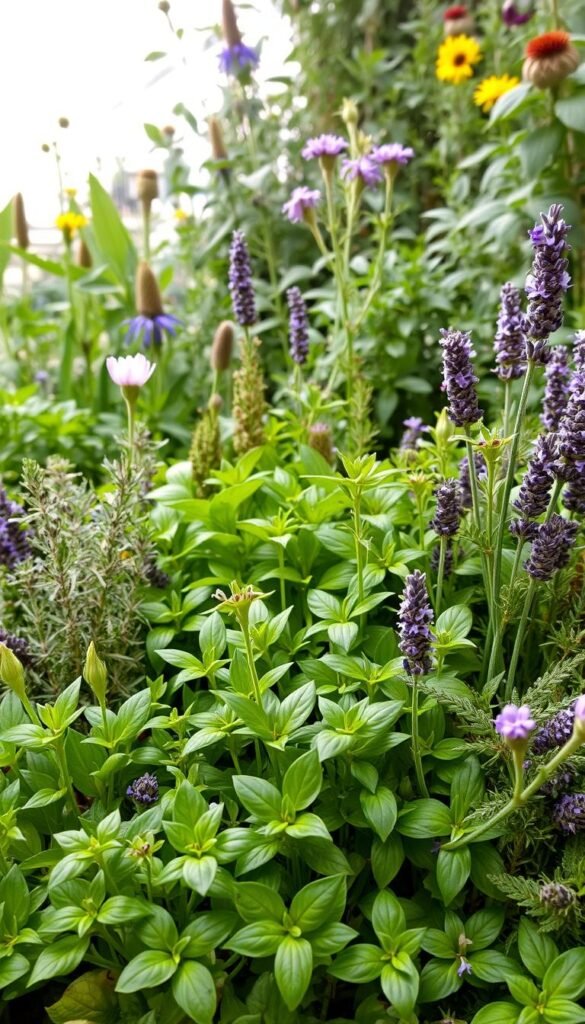
A thriving green space balances beauty with purpose. Select varieties that dazzle the eye while serving your wellness needs. Four standout options create layered interest through colors, textures, and healing properties.
Must-Have Plants for a Balanced Garden
Yarrow’s feathery leaves and clusters of white or pink blooms add airy texture to borders. Beyond its delicate appearance, it’s a natural bandage – crush leaves to stop minor bleeding. This perennial thrives in poor soil, asking little but giving much.
Feverfew’s daisy-like flowers brighten pathways while offering migraine relief. One gardener notes: “Chewing two leaves at headache onset often beats painkillers for me.” Its compact size suits container gardens or edging beds.
Lemon balm’s heart-shaped leaves release citrus scent when brushed. Steep them for calming tea that reduces anxiety within 20 minutes. Pair with purple sage for striking foliage contrast.
Passionflower vines create living curtains of intricate purple blossoms. Their evening fragrance enhances relaxation, while leaves promote restful sleep. Train them over arbors for shaded seating areas buzzing with pollinators.
| Plant | Visual Appeal | Key Benefits |
|---|---|---|
| Yarrow | Cloud-like flower clusters | Wound care, drought tolerance |
| Feverfew | Cheerful mini-daisies | Headache relief, compact growth |
| Lemon Balm | Textured lime-green leaves | Stress reduction, rapid spread |
| Passionflower | Exotic purple blooms | Sleep support, vertical interest |
Creative Garden Design Ideas for Herbs
Transform your green space into a living canvas with clever pairings and vibrant displays. Strategic design choices maximize both beauty and functionality, letting you harvest flavors while enjoying nature’s artistry.
Incorporating Companion Planting and Artful Arrangements
Pair lavender with roses – their purple flowers create harmony while repelling aphids naturally. Marigolds make golden borders that deter pests from basil and tomatoes. This approach blends well with edible landscaping principles.
Try triangular groupings for visual impact. Place tall fennel behind bushy parsley, with creeping thyme softening edges. These layers create depth while improving air circulation.
Using Containers to Boost Your Garden’s Charm
Follow the “thriller, filler, spiller” formula. Name a bold centerpiece like lemon verbena, surround it with parsley (filler), and let nasturtiums cascade over edges. This works wonders on patios and balconies.
Refresh arrangements each spring using colorful pots. Mix textures – try terracotta with glazed ceramics. Group 3-5 containers at varying heights for museum-worthy displays that name your personal style.

